(1 云南大学资源环境与地球科学学院, 云南 昆明650091; 2 中国地质科学院矿产资 源研究所 国土资源部成矿作用与资源评价重点实验室, 北京100037; 3 国家地质实验 测试中心 中国地质科学院Re_Os重点实验室, 北京100037; 4 山东省地质科学实验研究 院 国土资源部金矿成矿过程与资源利用重点实验室 山东省金属矿产成矿地质过程与资源利 用重点实验室, 山东 济南250013)
投稿时间:2015_06_08
录用时间:2016_06_15
本文得到“国家自然科学青年基金”项目(编号:41402070)和 “中国矿产地质与成矿规 律综合集成和服务”项目(编号:DD20160346)联合资助
1 School of Resource Environment and Earth Sciences, Yunnan University, Kunmin g 650091, Yunnan, China; 2 MRL Key Laboratory of Metallogeny and Mineral Asses s ment, Institute of Mineral Resources, Chinese Academy of Geological Sciences, Be ijing 100037, China; 3 National Research Center for Geoanalysis, Key Laboratory of Re_Os Isotope Geochemistry, CAGS, Beijing 100037, China; 4 Shandong Institut e of Geological Sciences, Shandong Key Laboratory of Geological Processes and Res ource Utilization in Metallic Minerals, Key Laboratory of Gold Mineralization Pr ocesses and Resources Utilization Subordinated to the Ministry of Land a nd Resources, Jinan 250013, Shandong, China

|
图 1桃科岩体大地构造位置(据Wan et al., 2006修改)
1—古元古代造山带中出露的古元古代火山沉积建造; 2—古元古代出露的古元古代沉积 建造; 3—东、西部(阴山、鄂尔多斯)陆块; 4—古
元古代造山带中被埋藏基底 ; 5—古元古代造山带中出露的太古代基底; 6—主要断裂
Fig. 1The tectonic location of the Taoke mafic_ultramafic intrusion (modified after Wan et al., 2006)
1—Exposed Paleoproterozoic volcanic_sedimentary unit in the Paleoproterozoic or ogens; 2—Exposed Paleoproterozoic sedimentary unit in the Paleoproterozoic orog ens; 3—Eastern and Western (Yinshan and Ordos) Blocks; 4—Hidden basement in th e Paleoproterozoic orogens; 5—Exposed Ar_
chaean basement in the Paleopr oterozoic orogens; 6—Major fault
|
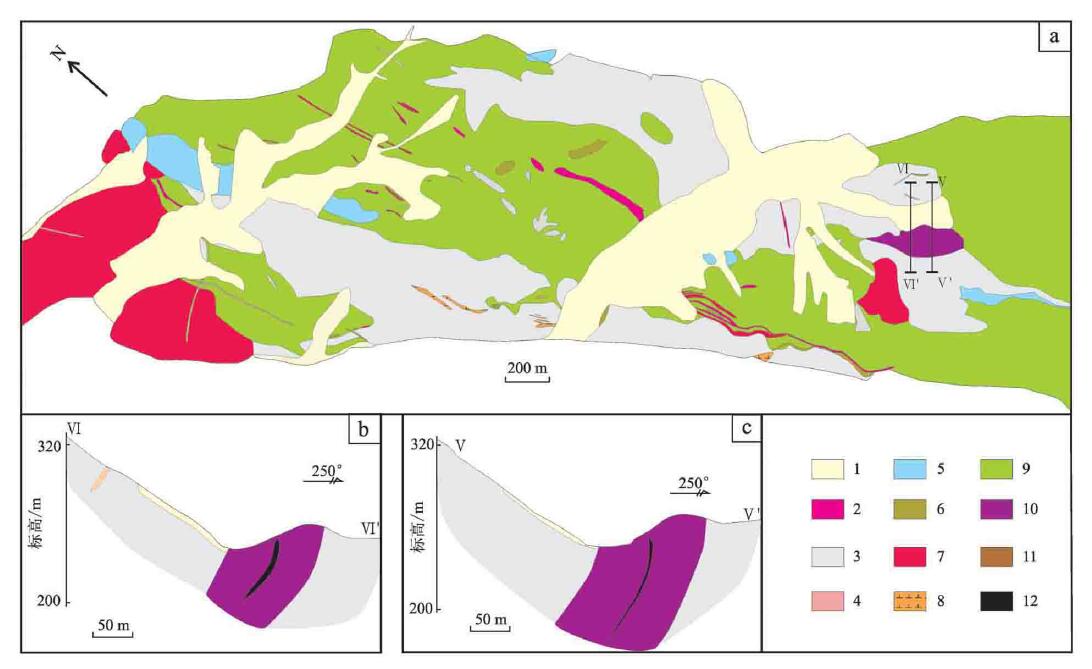
|
图 2山东桃科铜镍矿床地质简图(a)和红洞沟矿体中Ⅵ号(b)、Ⅴ号(c)勘探线剖面 图(据冶金工业局502队,1958修改)
1—第四系; 2—片岩; 3—片麻岩; 4—细晶岩; 5—角闪岩; 6—变质玢岩; 7—花 岗岩; 8—闪长岩; 9—变辉长岩; 10—橄榄苏长辉长岩;
11—褐铁矿化; 12 —硫化物矿体
Fig. 2Simplified geological map of the Taoke intrusion(a), the Ⅵ (b) and Ⅴ ( c) geological section of the Hongdonggou
orebody (modified after the report of No. 502 Geological Party, Metallurgical Industry Bureau, 1958)
1—Quaternary; 2—Schist; 3—Gneiss; 4—Aplite; 5—Amphibolite; 6—Metamorphic p orphyrite; 7—Granite; 8—Diorite; 9—Metamorphic
gabbro; 10—Olivine gabbro norite; 11—Ferritization; 12—Sulfide orebod
|
对硅酸盐矿物(如橄榄石、辉石、角闪石、斜长石)和金属矿物(如黄铁矿、黄铜矿、针镍 矿、镍黄铁矿)的电子探针微区分析在国土资源部成矿作用与资源评价重点实验室采用JXA_ 8230型电子探针进行。重点开展了:背散射电子像观察和成分定量分析。采用 的工作条件为:电流2.0×10-8A,电压15 kV,以获得最高的峰背比和最好的空间分 辨率,电 子束半径1~3 μm。金属硫化物测试中标准样品Cu元素采用黄铜矿,Fe、S元素采用黄铁矿 ,Ni元素采用硫镍矿。
辉石主要为古铜辉石和普通辉石(图4),普通辉石有2种: 一种Mg、Fe含量相对较高、C a含量相对较低;另一种Ca含量相对较高,Mg、Fe含量相对较低,前者可能较后者结晶 早,为与古铜辉石过渡阶段结晶矿物;辉石常发生绿泥石化和纤闪石化,常包裹橄榄石及早 期自形的斜长 石,形成包含结构。斜长石多发生钠黝帘石化,新鲜的斜长石环带和双晶均较发育,聚片双 晶、卡_钠复合双晶均有;斜长石可分为2期结晶:一类是包含在橄榄石晶体内部(图3c、e 、f),呈自形的细小的粒状,多数为培长石;另一类为与辉石总体上同期结晶,形成较为 典型的辉长结构,多数为培长石、拉长石,少量的中长石和钠长石(表1)。角闪石不多, 往往发生纤闪石化、阳起石化。根据矿物之间的接触关系,大体可将矿物结晶生成顺序划 分为如下:斜长石+橄榄石→斜长石+橄榄石+古铜辉石→古铜辉石+普通辉石(Ca含量相对较 低)+斜长石→普通辉石(Ca含量较高)+斜长石+角闪石。
黄铁矿的Co、Ni含量较低(表2),但Co/Ni比值较大,其变化范围也较大,为0.1~12.9 之 间,且不同世代的黄铁矿其Co、Ni含量及Co/Ni都不同(图6)。
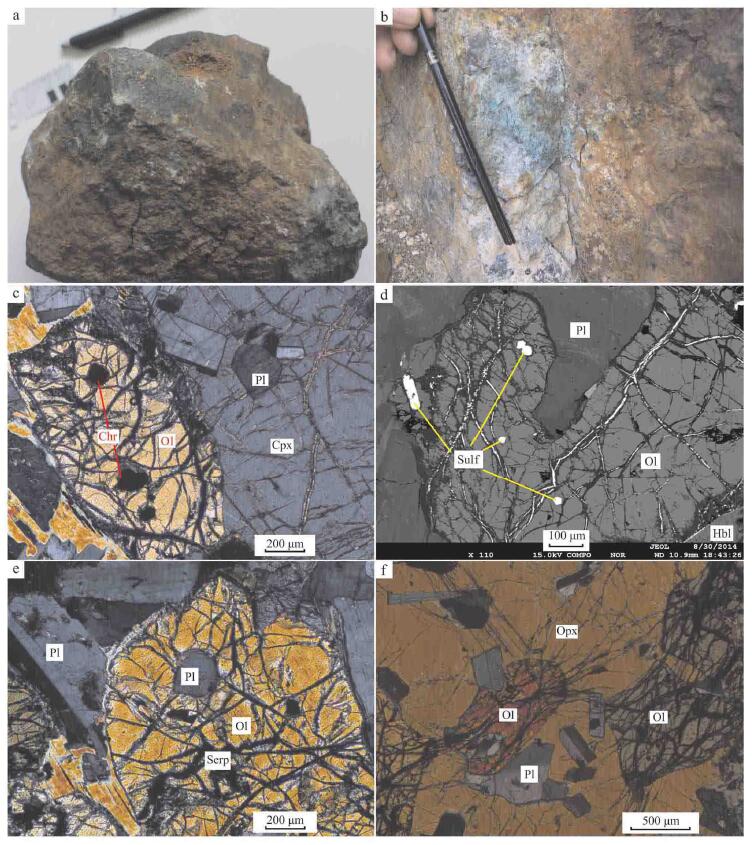
|
图 3桃科岩体显微镜下照片
a. 橄榄苏长辉长岩中稀疏浸染状硫化物; b. 地表橄榄苏长辉长岩上见有孔雀石化; c. 橄榄苏长辉长岩中橄榄石晶体里包裹铬铁矿,单斜辉石包裹早期自形斜长石; d. 橄榄石晶 体里早期形成的硫化物珠滴; e. 橄榄石发生蛇纹石化,包裹早期形成的斜长石; f. 斜方 辉石包裹
橄榄石和斜长石形成包含结构
Ol—橄榄石; Opx—斜方辉石; Cpx—单斜辉石; Pl—斜长石; Hbl—角闪石; Chr—铬 铁矿; Serp—蛇纹石; Sulf—硫化物
Fig. 3Photos of microphotographs of representative rock samples
a. Sparsely disseminated sulfides in the olivine gabbro norite; b. Malachitized alteration on the surface of the olivine gabbro norite; c. Chromite and plagiocl ase inclusions within olivine and clinopyroxene crystals, respectively; d. Small sulfide inclusions within olivine crystals, sulfide bearing olivine gab bro norite; e. Plagioclase inclusions within olivine crystals; f. Poikilitic texture of olivine gabbro norite Ol—Olivine, Opx—Orthopyroxene, Cpx—Clinopyroxene, Pl—Plagioclase, Hbl—Hornb lende, Chr—Chromite, Serp—Serpentine, Sulf—Sulfide |
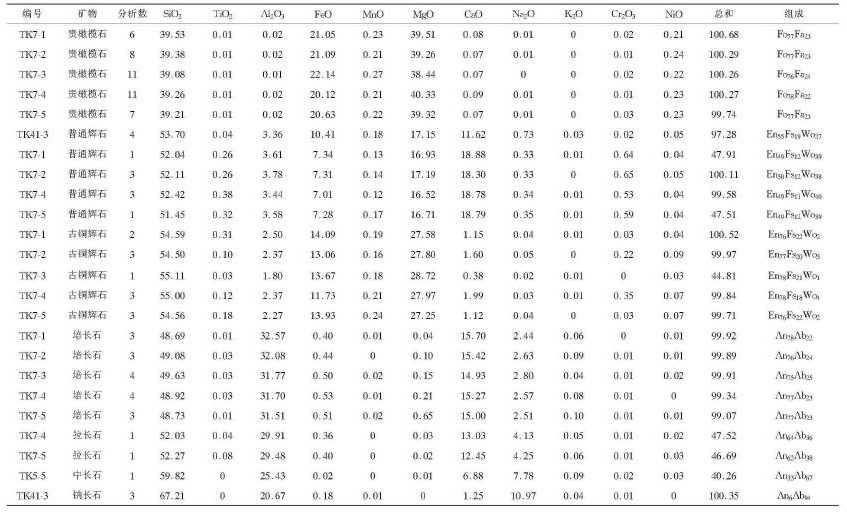
|
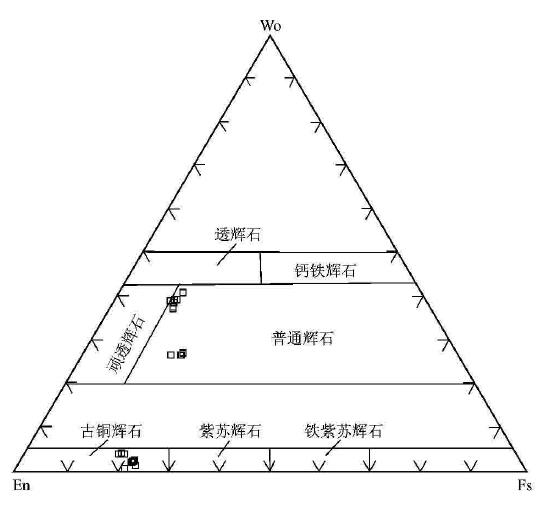
|
图 4辉石的Wo_En_Fs图解
Fig. 4Wo_En_Fs diagram of pyroxenee
|
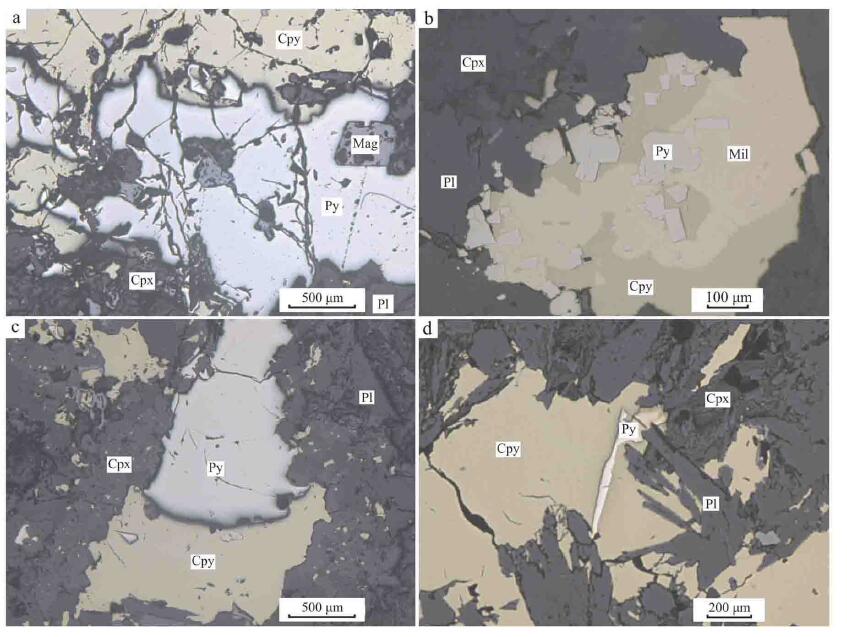
|
图 5桃科矿床中黄铁矿与其他硫化物关系
a. 黄铁矿与黄铜矿包裹早期自形的磁铁矿; b. 黄铜矿、针镍矿与早期自形的黄铁矿; c. 黄铁矿与黄铜矿接触界线较平直,黄铁矿在黄铜矿中
出溶; d. 黄铁矿呈叶片状在黄铜矿 中出溶
Cpx—单斜辉石; Pl—斜长石; Mag—磁铁矿; Py—黄铁矿; Cpy—黄铜矿; Mil—针镍 矿
Fig. 5The relationship between pyrite and other sulfides
a. Pyrite and chalcopyrite enclosing the early formed magnetite; b. Chalcopyrite , millerite and the early formed pyrite; c. Pyrite
and chalcopyrite exhibiting s traight contact boundary, and the pyrite exsolved in the chalcopyrtie; d. Lamina ted pyrite exsolved in the chalcopyrite
Cpx—Clinopyroxene, Pl—Plagioclase, Mag—Magnetite; Py—Pyrite; Cpy—Chalcopyri te; Mil—Millerite
|
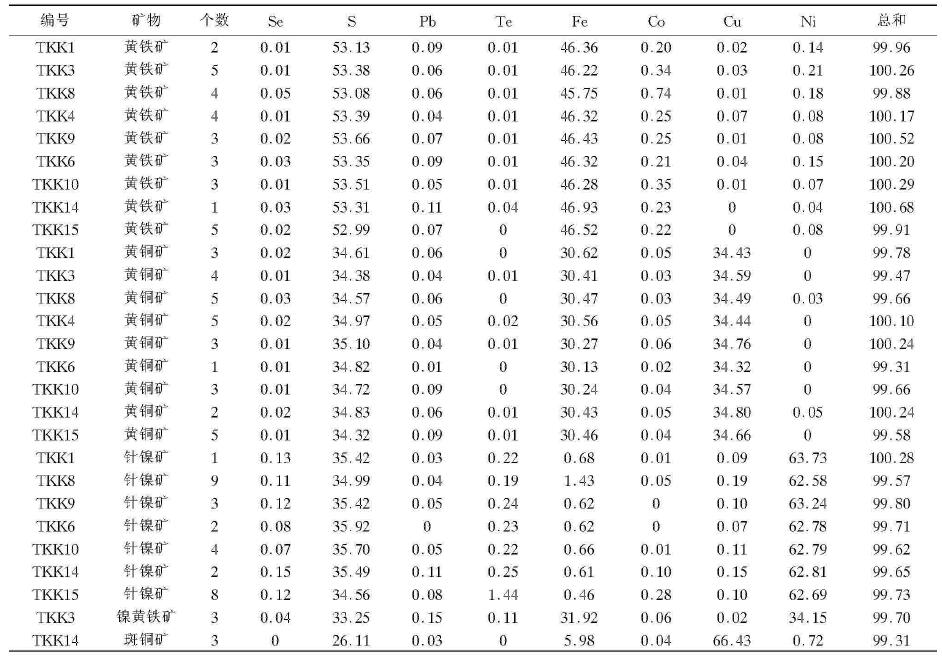
|
表 2桃科矿床硫化物电子探针分析结果(w(B)/%)
Table 2Electron microprobe analyses of the sulfides from the Taoke deposit( w(B)/%)
|
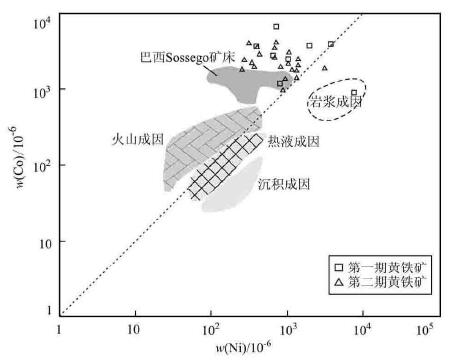
|
图 6桃科矿床中黄铁矿Co_Ni关系图解(底图据陈殿芬等,1995;巴西Sossego铁氧化物铜 金矿床数据引自Mon_teiro et al., 2008)
Fig. 6Co versus Ni diagram of the pyrite from the Taoke deposit (modified afte r Chen et al., 1995; data of the Sossego iron oxide copper gold deposit in Brazil after Monteiro et al., 2008)
|
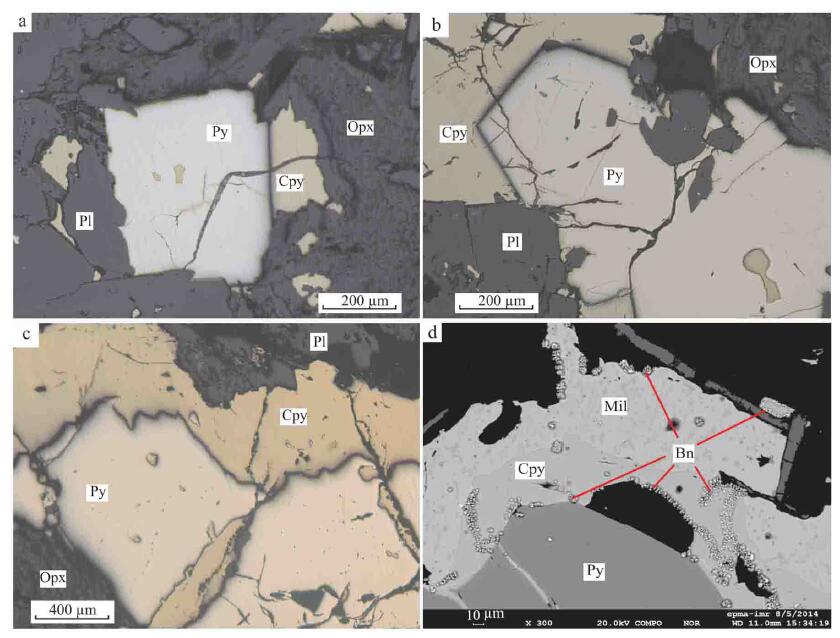
|
图 7桃科矿床中黄铜矿与其他硫化物关系
a&b. 黄铜矿与黄铁矿接触界线平直,黄铜矿在黄铁矿中出溶; c. 黄铜矿交代溶蚀黄铁矿 ,使黄铁矿呈锯齿状边界; d. 黄铁矿、黄铜矿、
针镍矿具有平直的接触界线,斑铜矿呈 细小的颗粒分布在黄铜矿边缘,具有热液的特征
Opx—斜方辉石; Pl—斜长石; Py—黄铁矿; Cpy—黄铜矿; Mil—针镍矿; Bn—斑铜矿
Fig. 7The relationship between chalcopyrite and other sulfides A & b. Chalcopyrite and pyrite exhibiting straight contact boundary, and the cha lcopyrite exsolved in the pyrite; c. Chalcopyrite replacing pyrite and forming t he serrated boundary; d. Pyrite, chalcopyrite and millerite exhibiting straight contact boundary, the small bornite distributed at the edge of the chalc opyrite and reflecting the characteristics of hydrothermal solution Opx—Orthopyroxene, Pl—Plagioclase, Py—Pyrite; Cpy—Chalcopyrite; Mil—Milleri te; Bn—Bornite
|
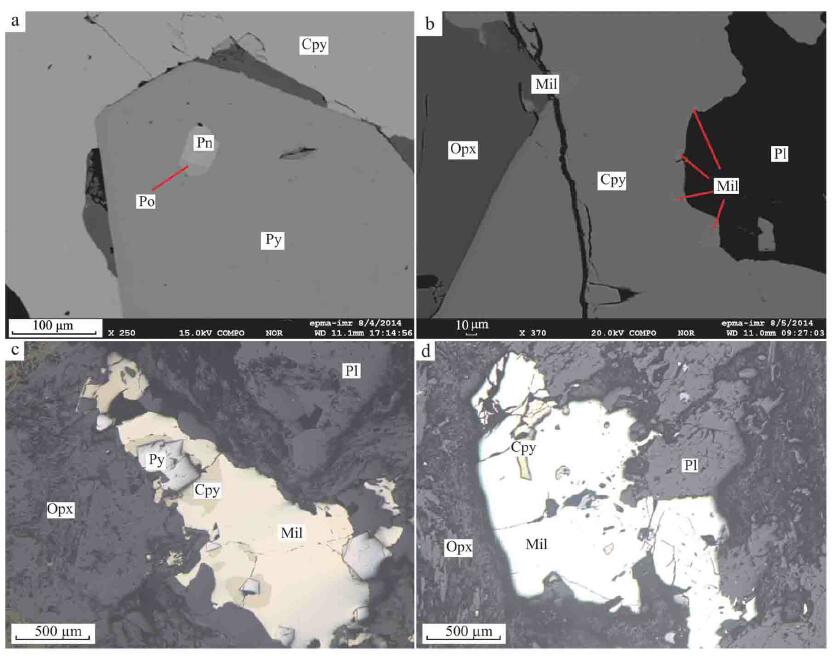
|
图 8桃科矿床中针镍矿与其他硫化物关系
a. 镍黄铁矿、磁黄铁矿、黄铜矿与黄铁矿,自形的镍黄铁矿未发生热液蚀变,与磁黄铁矿 共生; b. 针镍矿在黄铜矿边缘产出; c. 针镍矿与
黄铜矿包裹早期形成的自形的黄铁矿 ; d. 针镍矿交代黄铜矿呈孤岛状,形成交代残余结构
Opx—斜方辉石; Pl—斜长石; Py—黄铁矿; Cpy—黄铜矿; Po—磁黄铁矿; Pn—镍黄 铁矿; Mil—针镍矿
Fig. 8The relationship between millerite and other sulfides a. Pentlandite, pyrrhotite, chalcopyrite and pyrite, the euhedral pyrite exhibit ing no hydrothermal alteration and coexistent with pyrrhotite; b. the millerite distributed at the edge of the chalcopyrite; c. Millerite and chalcopyrite enclo sing the early formed pyrite; d. Millerite replaceing chalcopy_rite and forming replacement remnant texture Opx—Orthopyroxene, Pl—Plagioclase, Py—Pyrite; Cpy—Chalcopyrite; Po—Pyrrhoti te; Pn—Pentlandite; Mil—Millerite
|

|
表 3橄榄石的结晶温度
Table 3The crystal temperature of olivine
|
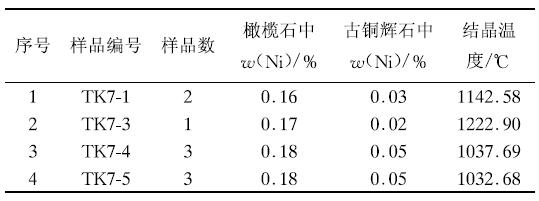
|
表 4古铜辉石的结晶温度
Table 4The crystal temperature of bronzite
|
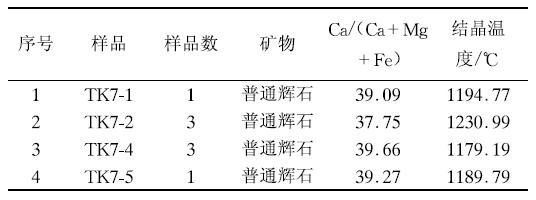
|
表 5普通辉石的结晶温度
Table 5The crystal temperature of clinopyroxene
|
邓晋福等(1987)通过数理统计得出的辉石形成温度的回归方程为,t=2258.55-27.2 17(Ca/(Ca+Mg+Fe))×100%,计算出本区单斜辉石的结晶温度如表5,单斜辉石的结晶温度 为1231~1179℃。
由表4和表5可以看出,不管是斜方辉石还是单斜辉石,它们的结晶温度范围都较大,说 明在更多温度条件下辉石均可以结晶;并且单斜辉石与斜方辉石结晶温度互有重叠,温度相 近,所以在桃科岩体中常可以见到2种辉石共存的矿物组合,这与实际在岩石薄片中(橄榄 苏长辉长岩)见到的2种辉石共生相一致。
桃科岩体主要由橄榄辉长苏长岩、蚀变辉长苏长岩、变辉长岩、角闪岩组成(图2a),岩石 的矿物组合为橄榄石+斜方辉石+单斜辉石+角闪石+斜长石,为典型的玄武质岩浆矿物组合; 矿石矿物中其原生的黄铜矿+镍黄铁矿+磁黄铁矿组合,为典型的岩浆型铜镍硫化物矿床的矿 物组合;以上特征表明矿床为岩浆成因。
但是,在地表或近地表,岩石发生了强烈的热液蚀变,如强烈的绿泥石化、钠黝帘石化、纤 闪石化等热液蚀变作用,地表岩石几乎见不到原生矿物组成,仅在钻孔岩心中尚能见到部分 稍微新鲜的岩石样品。矿区主要的含矿岩石为角闪岩,其原岩可能为橄榄辉长苏长岩。矿石 中针镍矿、斑铜矿等热液矿物的出现,表明岩浆期后有热液作用的存在;黄铜矿交代溶蚀黄 铁矿(图7c)以及黄铜矿也被针镍矿交代残余(图8d)等特征,表明矿石在形成过程中发生 了热液交代作用。黄铁矿的Co/Ni比值(0.1~12.9,平均4.1)较高,在图6中大部分样 品落 于巴西Sossego铁氧化物铜金矿床附近(Monteiro et al., 2008),仅有少部分样品落在岩 浆型铜镍矿床的范围,暗示桃科矿床在形成之后可能遭受了热液作用的叠加改造。在新疆香 山、陕西煎茶岭和西藏古玉拉矿床中也都见到针镍矿(肖凡等,2014;王瑞廷等,2005;刘 珂辛等2013),它们为岩浆期后热液作用的产物。山东桃科矿床可能是来源于地幔的玄武 质岩浆 在深部发生硫化物熔离、上升、就位成矿,在地壳浅部发生较强烈的热液蚀变作用,表现为 矿石中针镍矿、斑铜矿的出现,所以该矿床应该属于岩浆熔离_热液改造成因。
(2) 岩浆期金属矿物总体生成顺序为:磁铁矿+铬铁矿+钛铁矿→磁铁矿+第一期黄铁矿→ 第 二期黄铁矿+黄铜矿+镍黄铁矿+磁黄铁矿(极少量);针镍矿和斑铜矿应该为岩浆期后热液 作用的产物。
(3) 桃科岩体橄榄石开始结晶温度大约在1421℃左右,古铜辉石和普通辉石的结晶温度在 1030~1230℃之间,两矿物相在岩石中可以共存。
(4) 岩石学及矿物学特征表明桃科矿床为岩浆熔离成因,在后期遭受了强烈的热液叠加改 造作用。
志谢本文在野外工作中得到了山东省地质科学研究院于学峰院长、李大鹏博士 的支持与 帮助;在电子探针分析测试过程中得到了中国地质科学院矿产资源研究所陈振宇副研究员的 帮助;两名审稿专家提出了非常好的修改意见;在此一并志谢!
Chen D F. 1995. Characteristics of main metallic minerals in some copper_nickel sulfide deposits of China [J]. Acta Petrologica et Mineralogica, 14(4): 34 6_348 (in Chinese with English abstract).
Chen Z, Yu Z X and Huang Z R. 1956. On the violarite of the Taoke Ni_Cu deposit in Shandong [J]. Acta Geologica Sinica, 36(4): 525_533 (in Chinese with Englis h abstract).
Deng J F, Lu F X and E M L. 1987. The origin and ascending p_t path of the Hannu oba basaltic magma [J]. Geological Review, 33(4):317_324 (in Chinese with Engl ish abstract).
Gao Y L, Tang Z L, Song X Y, Tian Y L and Meng Y Z. 2009. Study on genesis of th e concealed Cu_rich ore body in the Jinchuan Cu_Ni deposit and its prospecting i n depth [J]. Acta Petrologica Sinica, 25 (12): 3379_3395 (in Chinese with Engl ish abstract).
Jiang X D, Wei G F and Nie J T. 2010. Jianchaling nickel deposit: Magmatic or hy drothermal origin[J]? Mineral Deposits, 29(6): 1112_1124 (in Chinese with En gli sh abstract).
Li H J and Tian X. 1995. Mineral minor element modal characteristics of Lancang Pb_Zn_Ag_Cu deposit in Yunnan [J]. Journal of Southwest Chian Institute of Tec hnology, 10(4):71_75 (in Chinese with English abstract).
Li W Y. 2007. The current status and prospect on magmatic Ni_Cu_PGE deposits [J ]. Northwestern Geology, 40(2):1_28 (in Chinese with English abstract).
Liu K X, Zhong K H and Zhang Y Q. 2013. The comparative study on the metallogeni c types of the Yugula nickel deposit in Bange, Xizang[J]. Acta Mineralogi ca Sinica, 33(S1): 114_115 (in Chinese).
Metallurgical Industry Bureau 502 team. 1958. The report of the Taoke Ni_Cu depo sit, Licheng, Shandong Province[R]. (in Chinese).
Mi M, Chen Y J, Sun Y L, Wang Y and Jiang H Z. 2009. Rare earth element and plat inum_group element geochemistry of the Zhou´apos;an Ni_Cu_PGE deposit in Henan Provin ce: Implications for hydrothermal origin [J]. Acta Petrologica Sinica, 25(11): 2769_2775 (in Chinese with English abstract).
Monteiro L V S, Xavier R P, Hitzman M W, Juliani C, Filho C R D S and Carvalho E D R. 2008. Mineral chemistry of ore and hydrothermal alteration an the sossego oirn oxide_copper_gold deposit, Carajas mineral province, Brazil [J]. Ore Geol ogy Reviews, 34: 317_336.
Ripley E M, Sarkar A and Li C S. 2005. Mineralogic and stable isotope of hydroth ermal alteration on the Jinchuan Ni_Cudeposit, China[J]. Econ. Geol., 100: 1349_1361.
Sun T, Wang D H, Qian Z Z, Fu Y, Chen Z H and Lou D B. 2015. A preliminary revie w of the metallogenic regularity of the nickel deposits in China [J]. Acta Geo logica sinica (English Edition), 89(4): 1375_1397.
Tang Z L and Li W Y. 1995. Jinchuan copper nickel sulfide (Platinum) metallogeni c model and comparison of geological[M]. Beijing: Geological Publishing Ho use.1_209(in Chinese).
Wan Y S, Song B, Liu D Y, Simon A Wilde, Wu J S, Shi Y R, Yin X Y and Zhou H Y. 2006. SHRIMP U_Pb zircon geochronology of Palaeoproterozoic metasedimentary rock s in the North China craton: Evidence for a major late Palaeoproterozoic tectono thermal event[J]. Precambrian Research, 149: 249_271.
Wang R T, Mao J W, Ren X H, Wang J Y and Wang X H. 2005. Ore composition and hos ting condition in the Jianchaling sulfide nickel deposit, Shaanxi Province [J] . Journal of Earth Sciences and Environment, 27(1): 34_38 (in Chinese with English abstract).
Xia L Q. 1981. Olivine geothermometer[J]. Nothwest Geoscience, 2(1): 73_82 (in Chinese with English abstract).
Xiao F and Wang M F. 2014. Characters of hydrothermal processes and their metall ogenic potential in Xiangshan Cu_Ni deposit, Xinjiang[J]. Resources Survey and Environment, 35(4): 270_279(in Chinese with English abstract).
Xie X, Li W Y, Gao Y B, Zhang Z W and Guo Z P. 2014. Mineralogy, geochemistry an d genesis of the Lashuixia Ni_Cu sulfide deposit in the Qilianshan mountains [J ]. Geology and Exploration, 50(4): 617_629(in Chinese with English abstract).
附中文参考文献
柴凤梅,张招崇,毛景文,董连慧,张作衡.2005.岩浆型Cu_Ni_PGE硫化物矿床研 究的几个问题探讨[J].矿床地质,24(3):326_335.
陈殿芬.1995.中国一些铜镍硫化物矿床主要金属矿物的特征[J].岩石矿物学杂志,14(14) :345_354.
陈正,於祖相,黄子荣. 1956.山东桃科铜镍矿床中紫硫镍铁矿的研究[J]. 地质学报 ,36(4):525_533.
邓晋福, 路凤香, 鄂莫岚. 1987. 汉诺坝玄武岩岩浆起源及上升的p_t路线[J]. 地质论评, 33(4):317_324.
高亚林,汤中立,宋谢炎,田毓龙,孟远志. 2009. 金川铜镍矿床隐伏富铜矿体成因研究及 其深部找矿意义[J]. 岩石学报,25 (12): 3379_3395.
姜修道,魏钢锋,聂江涛. 2010. 煎茶岭镍矿——是岩浆还是热液成因[J]. 矿床地质,2 9(6): 1112_1124.
刘珂辛,钟康惠,张勇强. 西藏班戈县玉古拉镍矿床成因类型对比研究[J].矿物学报,20 13,33(S1):114_115.
李虎杰,田煦. 1995. 云南澜沧铅锌银铜矿床矿物微量元素标型特征[J]. 西南工学 院学报,10(4):71_75.
李文渊.2007.岩浆Cu_Ni_PGE矿床研究现状及发展趋势[J].西北地质,40(2):1_28.
糜梅,陈衍景,孙亚莉,王焰,江合中. 2009. 河南周庵铂族_铜镍矿床稀土和铂族元素地 球化学特征:热液成矿的证据[J]. 岩石学报,25(11): 2769_2775.
汤中立,李文渊.1995.金川铜镍硫化物(含铂)矿床成矿模式及地质对比[M].北京:地质 出版社.1_209.
王瑞廷,毛景文,任小华,汪军谊,王小红. 2005. 煎茶岭硫化镍矿床矿石组分特征及其赋 存状态[J]. 地球科学与环境学报,27(1):34_38.
冶金工业局502队. 1958. 山东省历城桃科铜镍矿[R].
夏林圻. 1981. 橄榄石地质温度计[J]. 西北地质科学,2(1):73_82.
肖凡,王敏芳. 2014. 新疆香山铜镍矿区热液作用性质及其成矿潜力研究[J]. 地质调查 与环境, 35(4): 270_279.
谢燮,李文渊,高永宝,张照伟,郭周平. 2014. 祁连山拉水峡铜镍硫化物矿床矿物学、地 球化学及成因[J]. 地质与勘探,50(4): 617_629.
 孙涛,李超,张增奇,孙斌,程伟,王登红.2016.山东桃科铜镍矿床矿物学特征及其对矿床成因的指示[J].矿床地质,35(4):724~736
孙涛,李超,张增奇,孙斌,程伟,王登红.2016.山东桃科铜镍矿床矿物学特征及其对矿床成因的指示[J].矿床地质,35(4):724~736